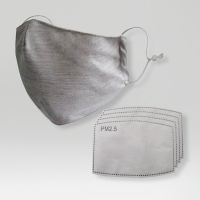This is a demo store. No orders will be fulfilled.
Call Our Herbalists
Herbal Consultations
KN95 Nano Protective Mask - 7 pack ($1 per mask)
- Clearance Sale: 50% Off. Consumer accounts only, while supplies last.
- Comparable to N95 Masks
- Filters out 95% or more of particulate matter of 0.1 micron in diameter or larger
- Protects against air borne pathogenic materials
- Lightweight, breathable and comfortable masks
Product Description
KN95 masks are considered respiratory protective equipment that conform to GB2626-2006 standards. They offer significant protection over standard surgical blue 3 ply masks and are approved by the CDC as acceptable replacements if N95 masks are unavailable.
These masks provide protection against harmful airborne matter based on the KN95 specifications, level 1. These are not meant as a replacement to the N95 masks; rather, an alternative source as indicated in the CDC link and for civil use.
For a comparison of the KN95 to the N95, please click under the Comparison Table tab below.
We have put together a guide regarding the reuse and rotation of these KN95 masks for you to get the most use and protection from them. However, it is important to note that KN95 masks are designed for one time use only. Any reuse is not ideal, though possibly necessary during the current pandemic.
Dr. Peter Tsai (retired from University of Tennessee), the inventor of the filtration fabric in the N95, gives us the following pointers regarding the reuse of N95 masks.
Mask Reuse Method #1
When reusing KN95 masks, leave a used mask in dry, atmosphere air for 3-4 days to dry it out. Polypropylene in KN95 masks is hydrophobic and contains zero moisture. (Keep in mind, COVID-19 needs a host to survive--it can survive on a metal surface for up to 48 hours, on plastic for 72 hours, and on cardboard for 24 hours.) When the mask is dry in 3-4 days, the virus will not be able to survive.
Based on an article published on 4/2/2020 in the prestigious medical journal The Lancet, Dragon Herbs highly recommends the masks are “quarantined” for at least 7 days before reuse and that they are disposed of after 2 to 3 weeks of use regardless of reuse/rotation methods.
Take seven (7) KN95 masks, and number them (#1-7)
- On day 1, use mask #1, then let it dry out for 7 days.
- On day 2, use mask #2, then let it dry out for 7 days.
- Same for day 3, and day 4… day 7.
Mask Reuse Method #2
You can also sterilize the KN95 mask by hanging it in the oven (without contacting metal) at 70°C (158ºF) for 30 minutes.
According to the Diagnosis and Treatment Plan (5th Edition) issued by the National Health Commission (NHC) of China, Covid-19 virus cannot survive at 56°C (133ºF) for 30 minutes. NHC is the lead agency in mainland China coordinating the national efforts to combat the 2019–20 Coronavirus outbreak.
Use a wood clip to hang the mask in the kitchen oven to do the sterilization.
When sterilizing KN95 masks, be wary of using UV light--keep N95 masks away from UV light / sunlight. KN95 masks are degraded by UV light because it damages the electrostatic charges in the polypropylene material. It is unclear how long the masks can be exposed to UV light before they are ineffective.
Tips for Reuse Methods #1 and #2
- DO NOT place the respirator on a metal surface, or too close to metal--the temperature on the metal surface is higher than the air temperature.
- Keep KN95 masks away from UV light / sunlight.
- When removing the mask, hold the edge of the straps attached to take off the KN95 mask. Your hands may be contaminated at this time--don’t touch the inside part of the respirator. Wash your hands with soap for 20 seconds afterward.
Face masks, which are sometimes called disposable respirators, are subject to various regulatory standards around the world. These standards specify certain required physical properties and performance characteristics for respirators to claim compliance with the particular standard. During pandemic or emergency situations, health authorities often reference these standards when making respirator recommendations, stating, for example, that certain populations should use an “N95, or equivalent” respirator.
The following is only intended to help clarify some key similarities between such references, specifically to the following FFR performance standards:
- N95 (United States NIOSH-42CFR84)
- KN95 (China GB2626-2006)
As shown in the following summary table, respirators certified as meeting these standards can be expected to function very similarly to one another, based on the performance requirements stated in the standards and confirmed during conformity testing.
Based on this comparison, it is reasonable to consider China KN95, as “equivalent” to US NIOSH N95 for filtering non-oil-based particles such as those resulting from wildfires, PM 2.5 air pollution, volcanic eruptions, or bioaerosols (e.g. viruses). However, prior to selecting a respirator, users should consult their local respiratory protection regulations and requirements or check with their local public health authorities for selection guidance.
Certification/ Class (Standard) |
N95 (US: NIOSH-42C FR84) |
KN95 (China: GB2626-20 06) |
| Filter performance – (must be ≥ X% efficient) | ≥ 95% | ≥ 95% |
| Test agent | NaCl | NaCl |
| Flow rate | 85 L/min | 85 L/min |
| Total inward leakage (TIL)* – tested on human subjects each performing exercises | N/A | ≤ 8% leakage (arithmetic mean) |
| Inhalation resistance – max pressure drop | ≤ 343 Pa | ≤ 350 Pa |
| Flow rate |
85 L/min | 85 L/min |
| Exhalation resistance - max pressure drop | ≤ 245 Pa | ≤ 250 Pa |
| Flow rate | 85 L/min | 85 L/min |
| Exhalation valve leakage requirement | Leak rate ≤ 30 mL/min | Depressurization to 0 Pa ≥ 20 sec |
| Force applied | -245 Pa | -1180 Pa |
| CO2 clearance requirement | N/A | ≤ 1% |
*From 3M’s Comparison of FFP2, KN95, and N95 and Other Filtering Facepiece Respirator Classes
![]() Click here to download the Comparison table (PDF).
Click here to download the Comparison table (PDF).
Definitions
Filter performance – the filter is evaluated to measure the reduction in concentrations of specific aerosols in air that passes through the filter.
Test agent - the aerosol that is generated during the filter performance test.
Total inward leakage (TIL) – the amount of a specific aerosol that enters the tested face mask via both filter penetration and faceseal leakage, while a wearer performs a series of exercises in a test chamber.
Inward leakage (IL) – the amount of a specific aerosol that enters the tested rface mask, while a wearer performs a normal breathing for 3 minutes in a test chamber. The test aerosol size (count median diameter) is about 0.5 micrometer.
Pressure drop – the resistance air is subjected to as it moves through a medium, such as a mask filter.
IMPORTANT: Always read and follow respirator user instructions.







